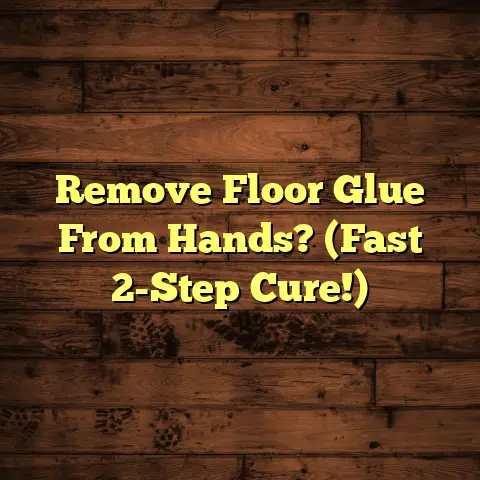Wood Look Tile: Good Idea? (7 Install Regrets!)
That’s the allure of wood look tile – the promise of beautiful, durable floors.
But hold on! As a flooring contractor with years in the trenches, I’ve seen it all. And trust me, wood look tile isn’t always a walk in the park.
Think of your home as a canvas, and your floors as the foundation of your masterpiece.
You want something that reflects your style, stands up to daily life, and maybe even boosts your home’s value.
Wood look tile can deliver that, but it’s crucial to go in with your eyes wide open.
I’m here to give you the real deal – the good, the bad, and the downright ugly when it comes to wood look tile.
We’ll explore why it’s become so popular, what makes it appealing, and most importantly, the seven biggest installation regrets I’ve seen homeowners face.
So, grab a coffee, settle in, and let’s dive into the world of wood look tile! Ready to find out if it’s the right choice for you?
Section 1: The Rise of Wood Look Tile
Let’s rewind a bit. Flooring has come a long way, hasn’t it? From simple earthen floors to intricate mosaics, we’ve always sought to cover our spaces in style and practicality.
Ceramic and porcelain tiles emerged as game-changers, offering durability and water resistance.
But they lacked the warmth and natural appeal of wood. Then BAM! Wood look tile enters the scene.
Historical Context
Think back to the early 2000s. Hardwood was king, but its vulnerabilities were well-known: scratches, water damage, the constant need for refinishing.
Tile manufacturers saw an opportunity. They started experimenting with printing techniques to mimic the look of wood on durable tile bodies.
It wasn’t perfect at first, but the technology rapidly improved. Now, you can find wood look tile that’s almost indistinguishable from the real thing!
Market Trends
The numbers don’t lie. Wood look tile is booming. According to a report by MarketWatch, the global ceramic tiles market is expected to reach \$79.84 billion by 2028, with wood look tile being a significant driver of that growth. https://www.marketwatch.com/press-release/ceramic-tiles-market-size-share-growth-trends-global-2028-2023-03-23
I’ve personally seen a huge increase in requests for wood look tile over the past decade.
Homeowners are drawn to its durability and the fact that it can be used in areas where hardwood would be a disaster, like bathrooms and kitchens.
Who’s buying it? Everyone! From young families to empty nesters, people are recognizing the value of this versatile flooring option.
Aesthetic Appeal
One of the coolest things about wood look tile is the sheer variety available. Want a rustic farmhouse vibe?
There are tiles that perfectly mimic weathered barn wood, complete with knots and imperfections.
Prefer a sleek, modern look? You can find tiles with smooth, consistent grain patterns in cool gray tones.
Think about the popular styles: * Distressed Wood: Replicates the look of reclaimed wood with variations in color and texture. * Wide Plank: Offers a modern, spacious feel with long, wide planks. * Herringbone: Allows for intricate and eye-catching patterns. * Exotic Wood: Mimics rare and expensive wood species, such as Brazilian Walnut or Teak.
The possibilities are endless! Manufacturers are constantly pushing the boundaries of what’s possible, creating tiles that capture the nuances of real wood in stunning detail.
Section 2: The Allure of Wood Look Tile
Okay, so we know wood look tile is popular. But why? Let’s break down the key factors that make it so appealing.
Durability
This is where wood look tile really shines. Compared to traditional hardwood, it’s in a different league.
Think about it: hardwood is susceptible to scratches from pets, dents from dropped objects, and warping from moisture.
Wood look tile? Not so much. It’s incredibly resistant to scratches, making it ideal for homes with kids and pets.
It’s also waterproof, so you don’t have to worry about spills or leaks ruining your floors. And it won’t fade in direct sunlight, so your floors will look beautiful for years to come.
I’ve seen wood look tile installed in high-traffic areas that would have destroyed hardwood in a matter of months. It’s a real workhorse!
Maintenance
Let’s be honest, nobody loves cleaning. And hardwood floors can be a real pain to maintain. You have to be careful about what you use to clean them, and you need to refinish them every few years to keep them looking their best.
Wood look tile? A quick sweep and mop with a mild detergent is all you need. No special cleaners, no waxing, no refinishing.
It’s incredibly low-maintenance, which is a huge plus for busy homeowners. I’ve had clients tell me that switching to wood look tile has freed up hours of their time each week!
Versatility
This is another area where wood look tile excels. You can use it virtually anywhere in your home.
- Kitchens: Its water resistance makes it perfect for kitchens, where spills are inevitable.
- Bathrooms: Forget worrying about moisture damage. Wood look tile can handle the humidity of a bathroom with ease.
- Living Areas: Create a warm and inviting space with the look of hardwood without the maintenance.
- Basements: Wood look tile is a great option for basements, which are often prone to moisture issues.
- Commercial Settings: Its durability makes it suitable for high-traffic commercial spaces like offices and retail stores.
I’ve even seen it used on walls to create unique and eye-catching accent features! Its versatility truly knows no bounds.
Section 3: The Installation Process
Alright, let’s get down to the nitty-gritty. The installation process is crucial to the success of any flooring project, and wood look tile is no exception.
Preparation
Proper preparation is the foundation of a successful installation. Skimp on this step, and you’re asking for trouble.
- Floor Leveling: Wood look tile requires a level surface. Any dips or unevenness in the subfloor can cause the tiles to crack or become uneven over time. I use a self-leveling compound to create a perfectly flat surface.
- Substrate Requirements: The subfloor needs to be clean, dry, and structurally sound. Cracks or damage should be repaired before installation. Plywood or concrete are common subfloor materials.
- Moisture Testing: Excessive moisture can cause problems with the adhesive and lead to tile failure. I always use a moisture meter to ensure the subfloor is within acceptable limits.
I can’t stress this enough: don’t skip these steps! I’ve seen countless installations fail because of inadequate preparation.
Installation Techniques
There are several different installation methods for wood look tile, each with its own advantages and disadvantages.
- Thin-Set: This is the most common method. The tile is adhered to the subfloor using a thin layer of mortar. It’s a durable and long-lasting option.
- Floating: In this method, the tiles are not directly adhered to the subfloor. Instead, they’re installed over an underlayment. It’s a faster and easier option, but it may not be as durable as thin-set.
- Modified Thin-Set: This type of mortar contains polymers that improve its flexibility and adhesion. It’s a good choice for areas with slight movement or vibration.
The best method for you will depend on your specific needs and the condition of your subfloor. I always recommend consulting with a professional to determine the right approach.
Common Mistakes
Even with the best preparation and techniques, mistakes can happen. Here are some of the most common installation errors I’ve seen:
- Uneven Tile Spacing: Inconsistent spacing between tiles can create an unprofessional look.
- Poor Grout Application: Grout that’s not properly applied can be prone to cracking and staining.
- Misaligned Tiles: Tiles that are not perfectly aligned can create a visually jarring effect.
- Using the Wrong Mortar: Using the wrong type of mortar can lead to poor adhesion and tile failure.
Avoiding these mistakes requires attention to detail and a thorough understanding of the installation process.
Section 4: 7 Install Regrets with Wood Look Tile
Okay, here’s the heart of the matter. These are the seven biggest regrets I’ve seen homeowners experience with wood look tile installations. Learn from their mistakes!
1. Choosing the Wrong Tile
It sounds simple, but this is a huge one. You might fall in love with a particular tile in the store, but it doesn’t mean it’s the right choice for your home.
- Aesthetic Mismatch: Does the tile complement your existing décor? Does it fit with the overall style of your home? I’ve seen homeowners choose tiles that clash with their furniture or wall colors, creating a jarring and unpleasant effect.
- Functional Needs: Does the tile meet your functional needs? Is it slip-resistant enough for a bathroom or kitchen? I had one client who chose a beautiful, but very slippery, tile for their bathroom. They quickly regretted it after a few near-falls!
Pro Tip: Bring home samples of different tiles and see how they look in your space under different lighting conditions.
2. Improper Subfloor Preparation
I hammered this point earlier, but it’s worth repeating. Neglecting subfloor preparation is a recipe for disaster.
- Cracks and Unevenness: These can cause the tiles to crack or become uneven over time.
- Moisture Issues: Excessive moisture can lead to mold growth and adhesive failure.
I’ve seen installations where the tiles started cracking within months because the subfloor wasn’t properly leveled. It’s a costly and frustrating mistake to make.
Pro Tip: Invest in proper subfloor preparation. It’s worth the extra time and money in the long run.
3. Poor Installation Technique
Rushing through the installation process or using incorrect methods can lead to a host of problems.
- Uneven Tile Spacing: This can create an unprofessional look and make the floor appear sloppy.
- Misaligned Tiles: Tiles that are not perfectly aligned can create a visually jarring effect.
- Weak Adhesion: Using the wrong amount of mortar or not applying it properly can lead to weak adhesion and tile failure.
I’ve seen DIY installations where the tiles were all over the place, with uneven spacing and misaligned edges. It looked terrible!
Pro Tip: If you’re not confident in your DIY skills, hire a professional installer. It’s an investment that will pay off in the long run.
4. Ignoring Expansion Gaps
Tile expands and contracts with temperature and humidity changes. If you don’t leave adequate expansion gaps, the tiles can buckle or crack.
- Placement of Expansion Gaps: Expansion gaps are typically placed around the perimeter of the room and around any fixed objects, such as pipes or columns.
- Size of Expansion Gaps: The size of the expansion gap will depend on the size of the room and the type of tile being used. A general rule of thumb is to leave a gap of at least 1/4 inch.
I’ve seen installations where the tiles started popping up because there were no expansion gaps. It’s a simple mistake to avoid, but it can have serious consequences.
Pro Tip: Always leave adequate expansion gaps when installing tile. Consult with a professional to determine the appropriate size for your project.
5. Mismatched Grout
Grout is more than just a filler between tiles. It plays a crucial role in the overall look of the installation.
- Color: Choosing the wrong grout color can detract from the overall look of the installation. A grout color that’s too light can show dirt and stains easily, while a grout color that’s too dark can make the tiles appear smaller.
- Type: Different types of grout have different properties. Epoxy grout is more resistant to staining and cracking than cement-based grout, but it’s also more expensive and difficult to install.
I’ve seen installations where the grout color clashed with the tiles, creating an unpleasant and distracting effect.
Pro Tip: Choose a grout color that complements your tiles and consider the long-term maintenance requirements.
6. Overlooking Maintenance
Wood look tile is low-maintenance, but it’s not no-maintenance. You still need to clean it regularly to keep it looking its best.
- Staining: Some types of tile are more susceptible to staining than others. Porous tiles can absorb spills and stains more easily than non-porous tiles.
- Cleaning: Using the wrong cleaning products can damage the tile or grout. Avoid using abrasive cleaners or harsh chemicals.
I’ve seen installations where the tiles became stained and discolored because the homeowners didn’t clean them properly.
Pro Tip: Choose a tile that’s easy to clean and maintain and use appropriate cleaning products.
7. Failing to Consider Resale Value
While wood look tile is generally considered a desirable flooring option, a poor installation can negatively impact your home’s resale value.
- Poor Workmanship: A shoddy installation can be a major turnoff for potential buyers.
- Outdated Style: Choosing a tile that’s trendy but likely to go out of style quickly can also hurt your resale value.
I’ve seen homes where the wood look tile was so poorly installed that it actually detracted from the overall appeal of the property.
Pro Tip: Choose a timeless style and ensure a high-quality installation to maximize your home’s resale value.
Section 5: Conclusion
So, there you have it – the good, the bad, and the ugly of wood look tile. It’s a fantastic flooring option that offers a great combination of aesthetics and practicality.
But, as we’ve seen, there are pitfalls to avoid. Choosing the wrong tile, skimping on preparation, making installation mistakes, and neglecting maintenance can all lead to regrets.
The key takeaway? Do your homework, plan carefully, and don’t be afraid to seek professional help.
Weigh the pros and cons, consider your specific needs and circumstances, and make an informed decision.
When done right, wood look tile can transform your living space into a beautiful and functional haven.
It’s an investment that can enhance your home’s value and your quality of life. So, go forth and floor with confidence! I hope I was helpful and if you have any questions, feel free to ask.





